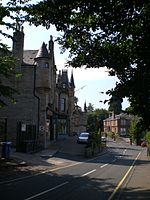Quarrier's Village

Quarrier's Village or Quarriers Village is a small settlement in the civil parish of Kilmacolm in Inverclyde council area and the historic county of Renfrewshire, in the west Central Lowlands of Scotland. It lies within the Gryffe Valley between the villages of Kilmacolm and Bridge of Weir, falling on the boundary between the modern Inverclyde and Renfrewshire council areas. Now a residential commuter village, Quarrier's was constructed as the Orphans Homes of Scotland in the late 19th century by philanthropist William Quarrier. In modern times, these orphans' homes and associated buildings have been converted into private housing and some expansion has taken place with new residential development. A charity under the name of Quarriers continues the work of the former homes and is based within the village.
Excerpt from the Wikipedia article Quarrier's Village (License: CC BY-SA 3.0, Authors, Images).Quarrier's Village
Hope Avenue,
Geographical coordinates (GPS) Address Nearby Places Show on map
Geographical coordinates (GPS)
| Latitude | Longitude |
|---|---|
| N 55.86833 ° | E -4.61666 ° |
Address
Hope Avenue
Hope Avenue
PA11 3TR
Scotland, United Kingdom
Open on Google Maps








